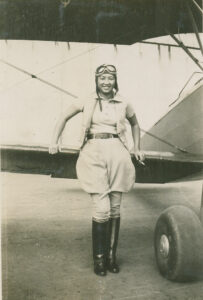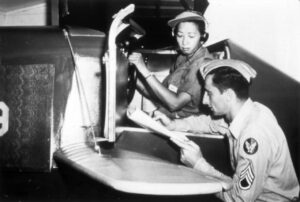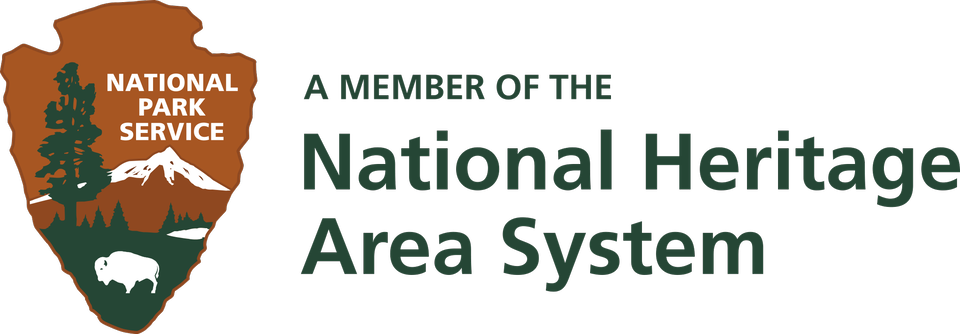The First Female Chinese-American Military Pilot
Despite being discriminated against based on her race and gender, Hazel Ying Lee was determined to fly.

When you think of women aviators, names like Amelia Earhart, Bessie Coleman, and Jacky Cochran probably come to mind. But have you heard of Hazel Ying Lee? In honor of Asian American and Pacific Islander Heritage month, read on to learn more about this fearless aviator and how you can celebrate her legacy here in Dayton, Ohio.
Hazel’s parents, Yuet Lee and Siu Lan Wong, were first-generation Chinese Americans who left their home province of Guangdong, China, to create a new life in Portland, Oregon. They welcomed their second child, Hazel, in 1912, only a decade after the Wright Brothers changed the world forever during their first successful powered flight in 1903. Despite facing racism throughout her childhood, Lee grew up to be a brave and active young adult who was involved in many sports and even earned her driver’s license as a teenager. Lee’s first experience with flight came in early 1932, when the nineteen-year-old rode along for a friend’s flight lessons. Although short-lived, this experience fundamentally changed the young woman’s life. Lee was smitten with aviation and found work as an elevator operator to pay for her own flying lessons. Soon after, she joined the Chinese Flying Club of Portland and quickly took to flying independently. Only a few short months after her first flight, Hazel became one of the first Chinese American women to earn her pilot’s license.
Lee’s next chapter began after the Japanese invasion of Manchuria in 1931. Although she was born in the United States, Lee still felt a deep connection with China. This connection spurred Lee to leave the United States and attempt to join the Chinese Air Force in 1933. Despite her strong desire to defend China and her exemplary flying skills, Lee was turned down for a pilot’s position with the air force because of her gender. Frustrated with this rejection, Lee obtained work in Guangzhou, China as one of the few commercial female pilots in the country. In 1938, after surviving the devastating bombing of Guangzhou, Lee returned to the United States to work for a company that provided aid and armaments to the Chinese army.
In 1942, Lee’s next aviation opportunity arose as the United States entered World War II and the Women Airforce Service Pilot organization, known as WASP, was formed. The WASP program trained women to become pilots to ferry aircraft, test planes, and perform other civilian aviation work, allowing more male aviators to serve in combat roles during the war. Shortly after the creation of WASP, Lee was accepted into the program’s fourth class, 43-W-4. Lee was one of only two Chinese American women accepted into the program and quickly rose to the top of her class, acting as a leader and mentor to the younger pilots in her cohort. Lee proved to be a fearless and tenacious pilot when she fell out of the plane she was riding in due to a faulty seatbelt. Miraculously, Lee saved herself by using a parachute to land safely and calmly walked back to the training camp, much to the surprise and delight of her fellow trainees and instructors.

After graduation, Lee was assigned to Romulus, Michigan, where she worked seven days a week to deliver newly manufactured aircraft around the country. Although competent, courageous, and hardworking, Lee still faced racism and gender stereotyping from the people around her. In fact, one harrowing incident occurred when Lee emergency-landed in a field where a farmer, thinking Lee was a Japanese soldier, accosted her with a pitchfork. While Lee survived this encounter unscathed and even managed to laugh about it with her fellow WASPs at base, this incident shows the blatant racism and mistrust Lee endured as a Chinese American-even while serving her country.
The final chapter of Lee’s aviation career came in 1944 when she was selected for intensive training in Texas to become one of the 130 WASPs who ferried high-powered fighter planes. Here, Lee fell in love with flying the P-51 Mustang, a long-range fighter-bomber which became one of the most prominent planes used in World War II. Tragically, Lee’s life-long adoration of flying also led to her premature death. On November 23, 1944, Lee was ferrying a P-63 Kobra when air traffic control mistakenly sent mixed signals to her and another pilot flying nearby, causing both planes to collide with one another in a fiery crash. Lee succumbed to her injuries from the accident a few days later. She was the 38th and final WASP to die in service to her country at only 32-years-old. She was remembered by her fellow WASPS as a funny, courageous, and skilled pilot who never turned down a flight delivery, no matter the danger involved.
Despite her undeniable contributions to the home front, Lee was not officially recognized as a military pilot by the United States after her death. In the years following the war, many former WASPs advocated for women pilots to receive formal recognition by the United States government for their service. Their efforts proved successful in 1977, when Congress officially recognized WASPs as military veterans. Additionally, in 2010, Lee was posthumously awarded the Congressional Gold Medal, finally getting the formal recognition she deserved for her bravery and sacrifice.

If you enjoyed learning about the inspiring story of Hazel Ying Lee you can celebrate her legacy this Asian American and Pacific Islander Heritage Month by visiting the types of planes she flew as a WASP, right here in the Dayton area. The Republic P-47 Thunderbolt, and Hazel’s favorite plane, the North American P-51 Mustang (pictured), are both on display at the National Museum of the United States Air Force in the World War II gallery.
Sources:
https://www.nationalww2museum.org/war/articles/women-airforce-service-pilot-hazel-ying-lee


